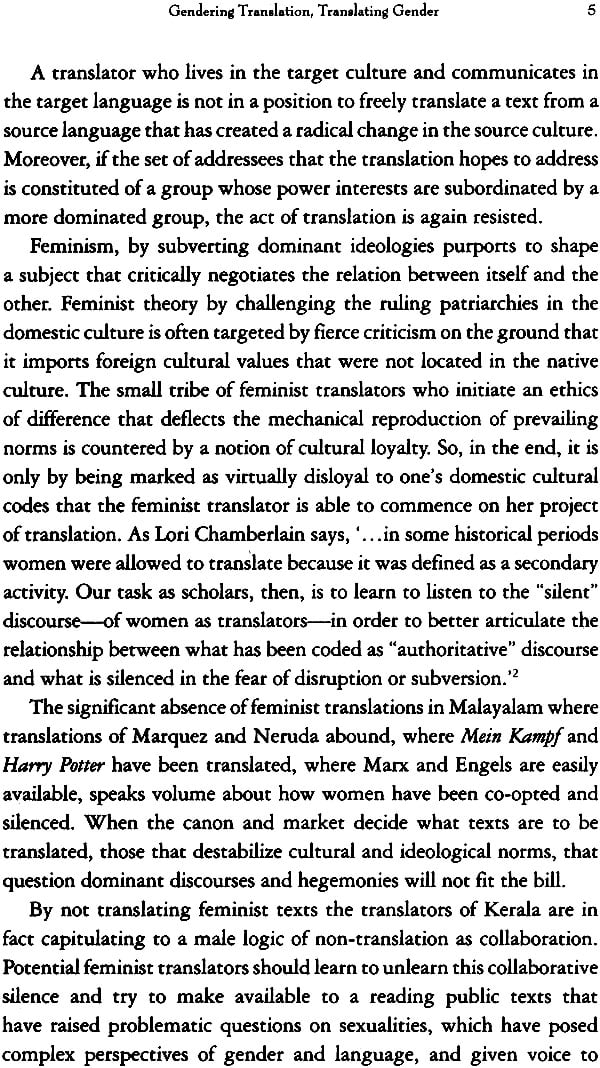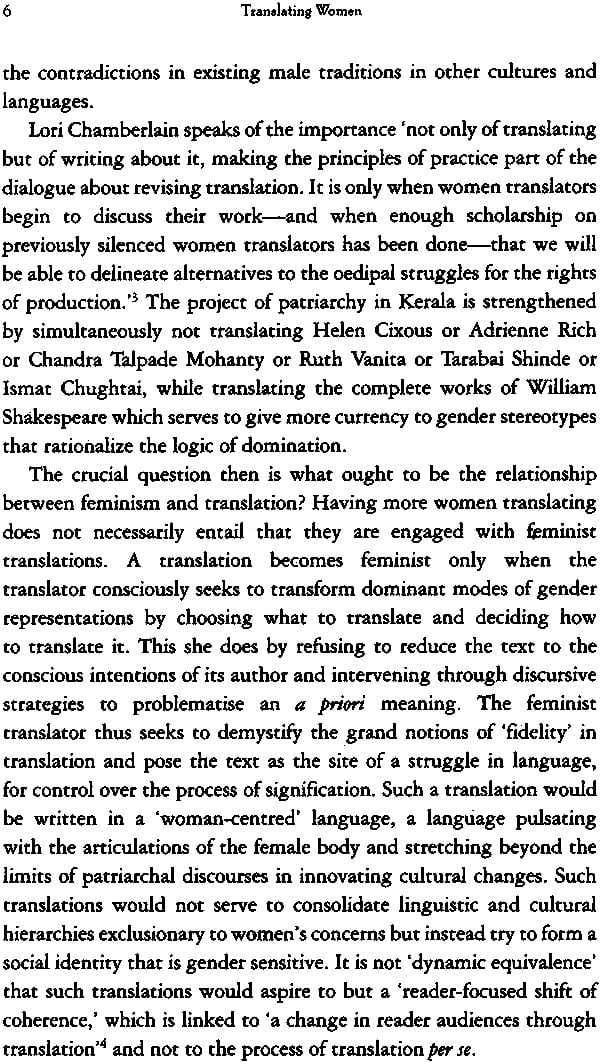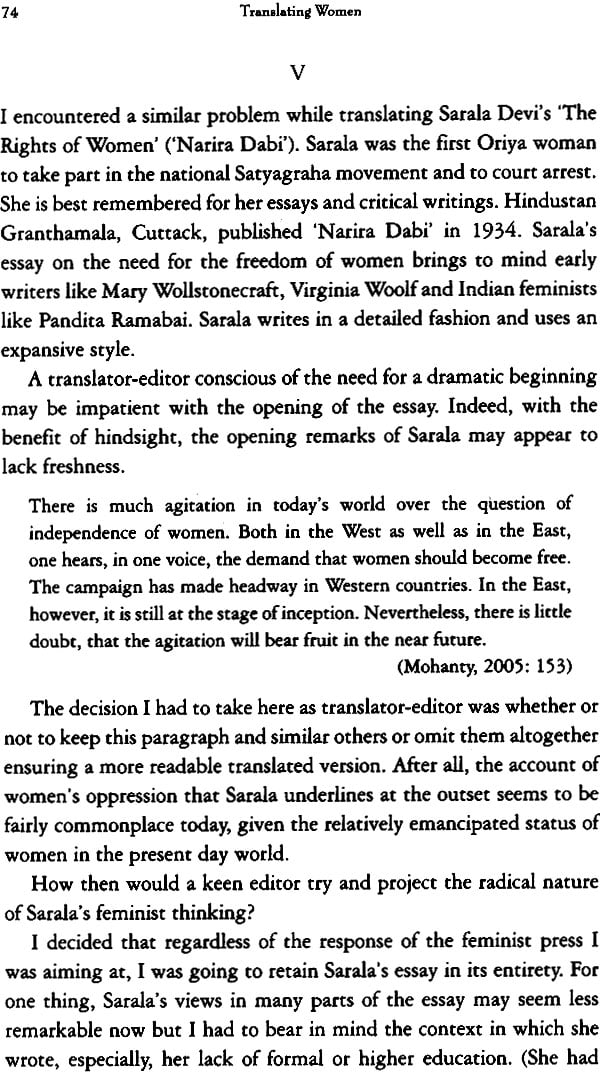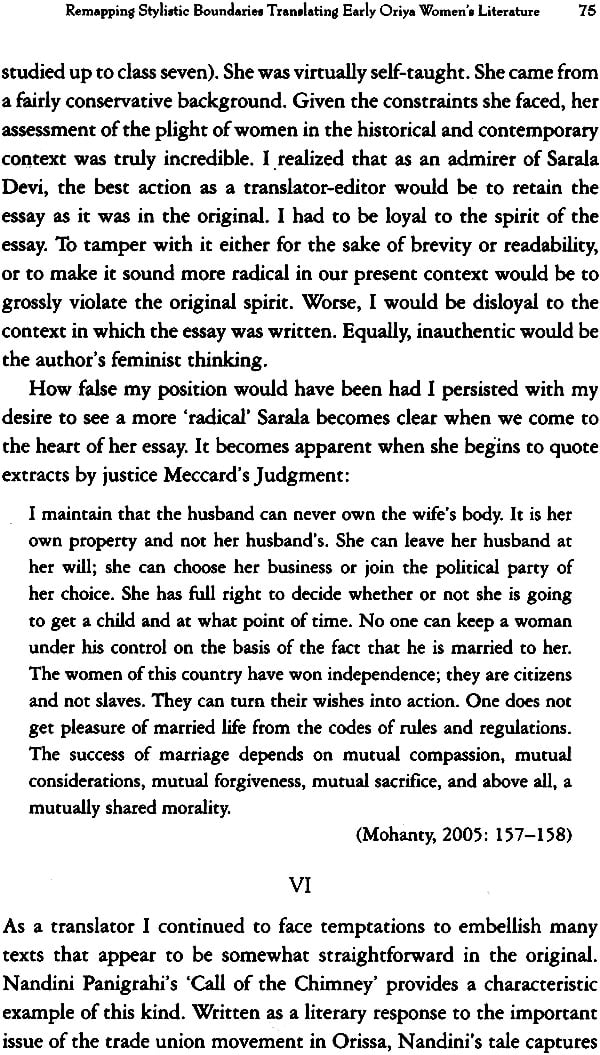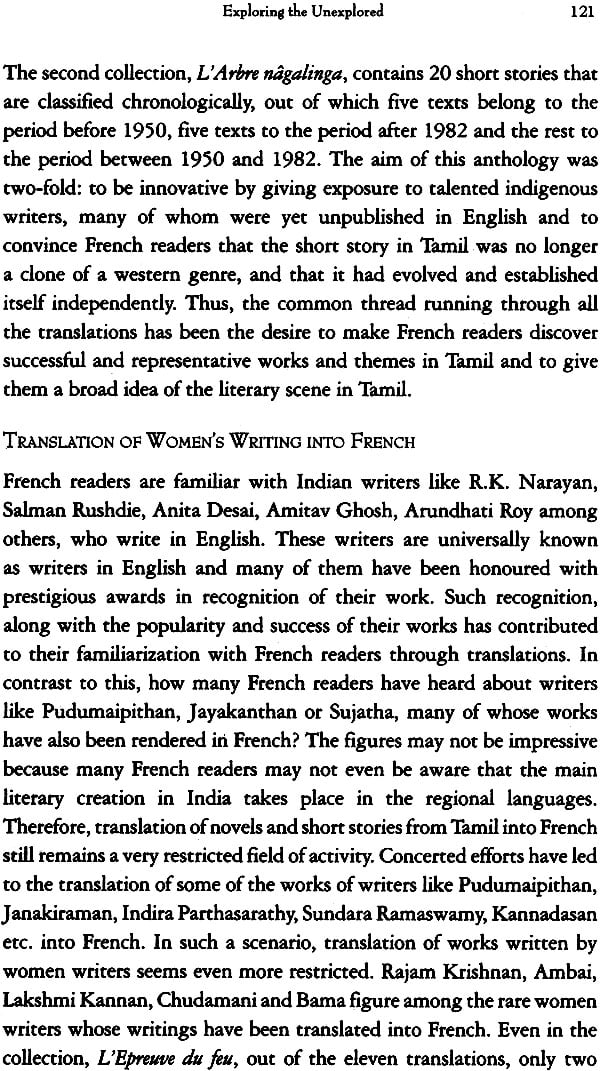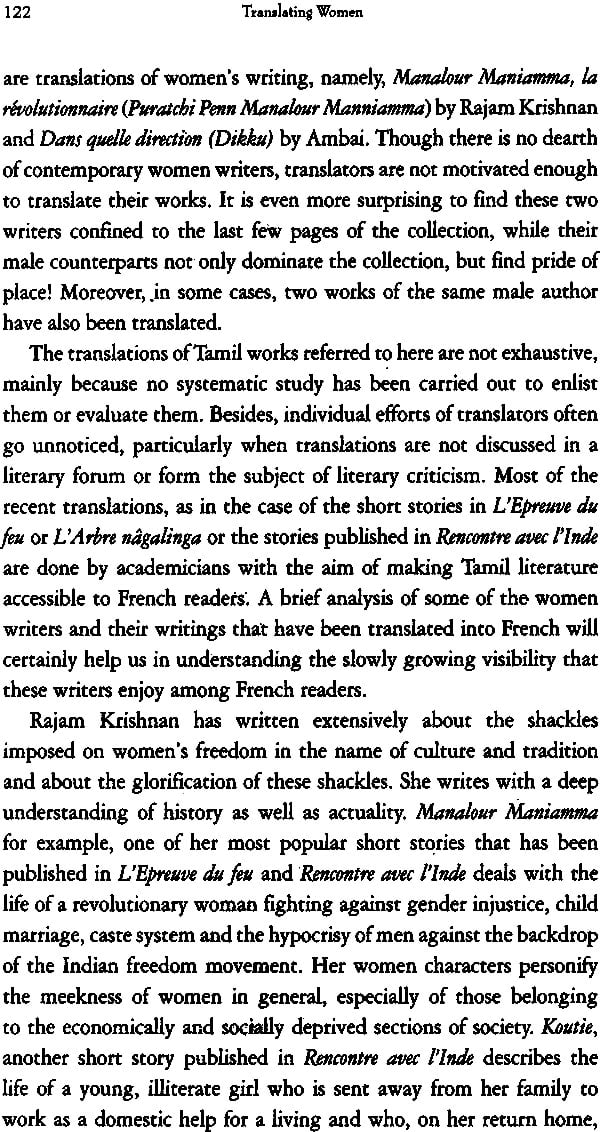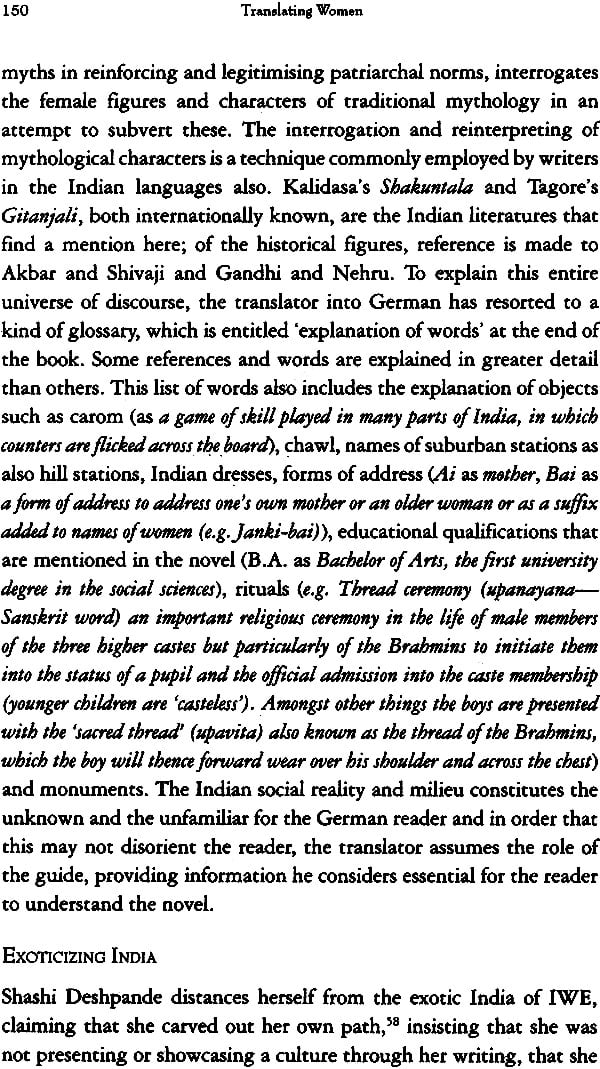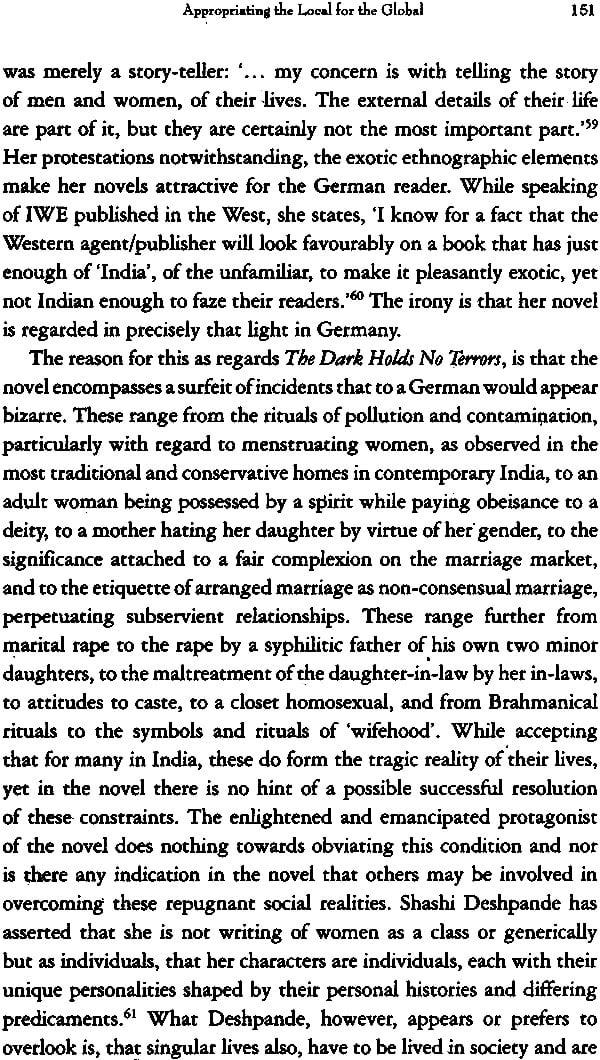
Translating Women (Indian Interventions)
Book Specification
| Item Code: | NAG263 |
| Author: | N. Kamala |
| Publisher: | Zubaan Publications |
| Language: | English |
| Edition: | 2009 |
| ISBN: | 9788189884680 |
| Pages: | 186 |
| Cover: | Hardcover |
| Other Details | 8.5 inch X 5.5 inch |
| Weight | 360 gm |
Book Description
About the Book
While women's language, women's writings, and women's views about the world we live in have all been the focus of much debate and study, this book explores the translation of these experiences and these writings in the context of India, with its multifaceted, multilingual character. If women's writing is different from the patriarchal language that forms the basis of communication in most language communities, what has been the impact of writings from the women's perspective and how have these writings been translated?
Indian women writers have been translated into English in the Indian context as well as into other western languages. What are the linguistic and cultural specificities of these literary productions? What is fore grounded and what is erased in these translations? What are the politics that inform the choices of the authors to be translated? What is the agency of the translators and of the archivist, in these cultural productions? What is the role of women translators? These are some of the questions that this book explores. The book contains insightful essays by some of the best translation scholars in India along with an in depth-introduction by the editor, N Kamala.
About the Author
N Kamala is professor of French at Jawaharlal Nehru University, New Delhi and specializes in translation studies. She has published widely on translation in India and abroad. She has awarded the Katha prize for translation in 1998. Her English translation of Toru Dutt's French novel The Diary of Mademoiselled' Arvers was published in 2005.
Introduction
The idea for this book came during a Translation seminar when a speaker as usual repeated the now infamous adage about 'Translations being like women, who if they are beautiful are unfaithful, and if they are faithful are not beautiful'. It was and remains remarkable that so many people refuse to question such sayings, their functions and their implicit complicity with what these quotations imply. A more sexist remark is difficult to find. By equating women and translations in this manner, the speaker had not only showed his own mindset but he had dismissed both in one swoop. However, the utterance of such positions underscores the politics that is inherent in the general attitude to literary works and translations, one the master and the other the slave. The immediate question that arose in my mind was what issues are at stake when women's writings get translated. Are such translated texts perforce doubly devalued for being literary products by women and then translated - unfaithful to the extreme limit? Are these second texts by the second sex subject to different parameters unlike male authored texts? What are the politics that inform these translations? How many or how few have actually been translated, when, where, how and why are some of the concerns that this book will attempt to address. The often unspoken but sometimes clearly voiced assumptions about this task are placed under critical scrutiny so that we can better understand the theoretical and practical underpinnings of translating women.
Women's language, women's writings, women's views about the world we live in, have all been the focus of much debate and study. The translation of these experiences and these writings, both fiction and theory, has been the object of study in very few languages. The one country that is an exception is Canada, more specifically the province of Quebec, which has debated long and hard on this aspect. Feminist writing from Quebec questions normative patriarchal language and is full of neologisms, word play, retrieval of old forgotten terms to describe women's experience. It brought about a new approach to translating these texts, and therefore other writing by women, so much so that there is now what is termed 'Feminist translation', wherein the feminist translator flaunts her presence and shows her intervention in the reading of the original text and ensures that women are present in language and therefore in society. This writing/ righting of women's literary production in another linguistic code is a rich exercise that shows the inherent prejudice and politics of language and translations themselves. This is as yet unexplored ground especially in the context of India, with its multifaceted, multilingual character. If women's language is different from the patriarchal language that forms the basis of communication in most language communities, what has been the impact of writings from the women's perspective and how have these writings been translated?
Peggy Kamuf refers to Northrop Frye's Anatomy of Criticism and shows how he equates a poet producing creative writing as being equal to a mid-wife, is in fact the womb of the mother, close to nature, as opposed to deliberate writing wherein the poet is the father of the text! So when women write are they being creative or deliberate, especially if, in any case, they can never be the fathers of their literary products? Is there such a thing as 'women's language' as opposed to 'men's language'? How women speak and are spoken of has been the subject of critical enquiry for the past three decades. It is now a truism to state that most terms designating women have derogatory resonances while their masculine counterparts have positive overtones. We but have to look at one classic example at the pair of words 'master' and 'mistress' to comprehend that this double standard works throughout in most languages. Marina Yaguello argues that language is, to a large extent, 'a cultural mirror that fixes symbolic representations, and is an echo of prejudices and stereotypes, while at' the same time [it} feeds and upholds them.' 0979: 8) The primary question that arises here is who gets to represent and who has the power to produce the symbols and control them? It is but a truism to state that so far language, cultural organizations, in fact all representations humanity has of itself are mainly 'determined by the gaze of men and imposed by them.' (Collin, F. 1992: 12) Since the right to name is the prerogative of the dominant group over a dominated one, men have always been the ones to define women's place and keep them there. The language so developed has therefore been referred to variously as he-man language, man-made language, or simply as Michele Causse puts it androlect. If writing itself is a translation of thoughts and ideas in the metaphorical sense then when women have to use this language, they are obliged to 'translate' this male discourse in the real sense in order to share their experience. This extends to what women are allowed to speak and what is considered taboo to them. Swear words, sexual experience or emotions, to name but a few were/are still denied to women. 'Girls, for example, are often discouraged from repeating expressions readily used by boys. Hence the use of gender- marked lexicons by men and women writers' avers Nelly Furman. (Mc Connel- Ginet 1980: 48) Therefore, it follows that, what would be considered normal speech for men would amount to shocking conduct for women. The 'correct' way of speaking is aptly termed 'verbal hygiene' by Deborah Cameron. (1995) Hence, to put across their experience in a language inherently closed to this effort, women have used the term 'translation' to describe their work. As Barbara Godard puts it, Translation, in its figurative meanings of transcoding and transformation, is a ropes in feminist discourse used by women writers to evoke the difficulty of breaking out of silence in order to communicate new insights into women's experiences and their relation to language.' (1989: 45) This has led the other Canadian Susanne de Lotbiniere-Harwood, to declare 'I am a translation because I am a woman' 0991: 95) and 'I am a translation because I am a bilingual' (ibid: 89). Bilingual because women are obliged to use two different codes within the same language, the dominant man language and the often silent women's tradition. So translating a 'translation' is a double translation that opens up interesting and challenging questions to explore.
The last two decades or so have seen the growth of several anthologies and individual works by Indian women writers that have been translated into English in the Indian context as well as into other western languages. What are the linguistic and cultural specificities of these literary productions? What differentiates, for example, a Telugu woman writer from a Hindi woman writer when they are both translated into a common western language? How are nuances of class, religion, or caste maintained, if at all? What is foregrounded and what is erased in these translations? What are the politics that inform the choices of the authors to be translated? What is the agency of the translators in these cultural productions? What is their place in this library of letters? What is the status of authors who are translators as well? Is translation into English the same as translating into other western languages?
If we do a brief survey first of some of the anthologies in English that have come out in India, we are struck by the agendas of the editors, publishing houses and of course the translators. What they do have in common is that they all deal with the category of 'women', the idea of the nation, or the notion of a sub-national identity of their regional location, and the fact that the various Indian languages have now found new avatars in the English language. English ensures not only a pan-Indian audience bur is also liable to be aimed at an international one. But the very pan-Indianness of English, perceived as 'a neutral language territory' (Mukherjee 1994: 35) for translation runs the risk of flattening out regional variations and homogenizing diverse writings. A risk the editors of Women Writing in India are fully aware of and address.
The pioneering work of Susie Tharu and K. Lalita was the first to break new ground with the kind of intensive archival work of recovering women's writings from over 2000 years ago to the present. Nelly Furman has correctly said that, 'In bringing forth the works which our literary prejudices have slighted, feminist historians of literature invest women writers with authorial powers bestowing on women's perspectives the authority hitherto reserved for men's views'. (McConnell-Ginet: p. 46) In the West women had to resort to male names or male sounding names to be published. George Elliot is one example from the literary past and from the current scene the popular children's author J.K. Rowling who used only her initials so that potential boy readers would not be put off by the fact of her being woman writer. (Shapiro 2000: 91) This misogynic prejudice has been offset by Susie Tharu and K. Lalita. Spanning two millennia, and covering a variety of languages from India, the two volumes are the happy merger of two academic disciplines - feminism and translation studies. Sherry Simon clearly states, 'As fields of inquiry which emerged during the 1970s and gained increasing institutional recognition through the 1980s, translation studies and feminist thought are similarly grounded in the dynamics of a period which gave strong prominence to language.(1996: 8) The two editors address the asymmetries of languages when they declare, 'that there are always relationships of power involved when one world is represented for another in translations' and when it is a question of regional Indian languages into English it entails the representation of a 'regional culture for a more powerful national or 'Indian' one and when this is made available abroad, it implies 'representing a national culture for a still more powerful international culture - which is today a Western one'. (1995: xx) As mentioned earlier they did not want to reduce or stereotype the translations and so opted for 'translations that did not domesticate the work into (a) pan-Indian mode'. The editors had even got different spellings for different regional pronunciation of common words until their attempt resembled an orientalist's work! So they abandoned this practice and went for more 'standard' spellings as in any case readers hardly ever oralised when they read a word. The translation strategy thus adopted, of preserving the diversity and uniqueness of each language and culture, meant that they had to omit those writers who could not be adequately translated. Krishna Sobti was left out as the translators could not effectively convey the earthy, lewd diction of her dialect. The second one was Balamani Amma whose ethos could not be recreated. They did not want these two individuals to be submerged by, and in, a larger national culture. While they concede that 'women writers may not be exempt from ideologies that shape their world', their editorial intention is to read these women's works 'for gestures of defiance or subversion implicit in them'. This attitude seems to echo Nelly Furman's statement, 'It is the reader's acumen, expectations, and unconsciousness which invest the text with meaning'. (McConnell-Ginet: 49) But this is the very danger Rajeshwari Sunder Rajan cautions against in her review of the work, for women's writing (according to her) is 'not always resistant' and she calls for a scrupulous historicisation of 'its conformism' (1993: 5). The editorial agenda presents the collection in a feminist framework and shows women's responses to historical developments and provides insights into the politics of everyday life. While the choice of authors itself is political, as in perhaps not choosing those who didn't fit their ideology, what is of interest is that they hardly give any importance to the translators, the cultural mediators who made these stories available in English.
Two other interesting anthologies are The Inner Courtyard edited by Lakshmi Holmstrom and Inner Spaces: New Writing by Women from Kerala edited by K.M.George. The similarity in titles is striking in so far as these bring to mind immediately the 'place of women in society'. The interior is the domain of the woman as opposed to the outside world of men. The Third Eye: Women Writings from Karnataka edited and translated by Lakshmi and T.V Subramanyam, and Trttth Tales edited by Meena Alexander, all insist through their very titles on the gender difference and the authenticity of women's experiences. K.M. George underlines the regional sub-culture in the title itself and states that Kerala is different with' its own distinctive sub-culture with its special customs and manners' (1993: xv). He questions the social position of women in this state as opposed to the other states of India and their literary contribution. The editor analyzes the specific Kerala matrilocal and matrilineal system of inheritano followed by the Nair community and claims the 'women in Kerala can be said to have shared more power than their counterparts in the rest of India'. He then adds that the various stories present 'a point of view unique to women. Not only are the protagonists female but, by and large, they search for meaning in their lives, or for liberation do not take the male idea of freedom and power.' While he had theoretically placed Kerala women in a position of power these stories revolve around the need for freedom and liberation. And their quest is highlighted in the different approach they adopt to that of men. Are the women being praised for their radical view points or are they being praised for not stepping into male territory and upsetting gender locations? The inevitable homogenization is striking as all women of Kerala have one unique point of view though they don't have any agenda. For he adds, 'It is important to note that the writers do not at any point, become mere message bearers of feminism. They are primarily creative writers.' Therefore they don't wave any feminist flag, but they all have a single point of view. The women chosen span four decades of writing write about diverse castes, different social groups and present different ideologies. While their difference from other women writers has been underscored, their similarity in hailing from the same state and not being mere feminists has been highlighted. On the other hand, Meena Alexander's Truth Tales argues for a separate anthology of women's writing in order 'to fracture established patterns point out the necessity of difference'. (1989: 14) Being aware of women's response to history and language ideology in varied areas is still no guarantee that this time around the homogenization takes place in accordance with feminist agendas. This brief overview shows that editors are aware of the politics of choice, power of languages, specific regional geographical locations, while presenting writings by women in translation. But the very genre of an anthology lends itself to an awkward homogenization that may not be intended but results in most cases. The stereophony of women's voices in the same language and then in different languages needs to be presented in all its diversity and multiplicity. As more and more full length works by women get translated editorial attention should focus on these subtleties and it is the aim of this book to look at some of this work done in the various Indian languages.
Contents
| Acknowledgements | Ix | |
| Introduction | Xv | |
| 1 | Gendering Translation, Translating gender: A case study of Kerala | 1 |
| 2 | Translation gendered, nation engendered: H.V. Savitramma's translations | 16 |
| 3 | Ambai: The language of love, desire and sexuality | 46 |
| 4 | To pierce a mustard seed and let in seven oceans | 63 |
| 5 | Remapping stylistic boundaries: Translating early oriya women's literature | 68 |
| 6 | Women's writing: Rewriting difference | 79 |
| 7 | When silences speak Translating muted voices: choices and challenges | 93 |
| 8 | Exploring the unexplored: Tamil women's writing in French translation | 111 |
| 9 | Appropriating the local for the global: Transporting shashi deshpande to German shores | 129 |
| Notes on contributors | 161 |
